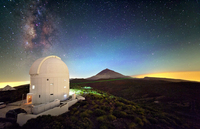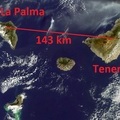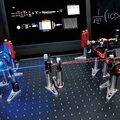|
Laser from Optical Ground Station on Tenerife
|
EU–(ENEWSPF)–6 September 2012. An international research team using ESA’s Optical Ground Station in the Canary Islands has set a new distance world record in ‘quantum teleportation’ by reproducing the characteristics of a light particle across 143 km of open air.
Funded by ESA, researchers from Austria, Canada, Germany and Norway transferred the physical properties of one particle of light – a photon – onto its ‘entangled’ partner via quantum teleportation, thereby bridging a distance of 143 km between the Jacobus Kapteyn Telescope on La Palma and ESA’s Optical Ground Station on adjacent Tenerife.
Their results have been published in this week’s Nature Magazine.
Once entangled, the measurement of a certain property – such as polarisation or spin – will yield the same result for both particles, no matter how far apart the particles are located, and without any further signal being physically passed between them.
|
Satellite image of Canary Islands
|
Quantum teleportation is not copying in the strictest sense however, since the act of transference destroys the original particle – its characteristics passing to its entangled counterpart.
A confounded Albert Einstein termed quantum entanglement “spooky action at a distance,” but it is a documented physical phenomenon, central to a coming generation of ultra-powerful quantum computers teleporting ‘quantum bits’ – qubits for short – of information, as well as for communication systems immune to interception.
“This achievement breaks new ground for long-distance quantum communications,” explained Eric Wille, overseeing the project for ESA.
“The first quantum teleportation took place in laboratory conditions. The challenge here was to maintain the entanglement between two photons separated by 143 km, despite being perturbed by atmospheric conditions, such that it could still be used for quantum teleportation.”
This involved such a low signal-to-noise ratio that the experiment had to be very carefully designed.
Ultra-low noise photon detectors were installed, and a separate process of quantum entanglement was used to keep the two station clocks synchronised to within three billionths of a second of each other.
|
Creating entangled photons
|
This helped to assure that the correct photons were detected – the best that GPS signals could deliver was 10 billionths of a second.
Even then, the team were kept waiting almost a year, after a first attempt in 2011 failed due to exceptionally bad weather.
The two telescope stations located on the volcanoes 2400 m above sea level have to face harsh conditions, including rain, fog and strong winds or even snow and sand storms.
The experiment finally took place in May, establishing a new record for the teleportation distance.
“The next step would really be to achieve quantum teleportation to a satellite in orbit to demonstrate quantum communication on a global scale,” commented Dr Rupert Ursin of the Austrian Academy of Sciences.
The inter-island measurement campaign was commissioned by ESA within its General Studies Programme in order to demonstrate the feasibility of long-distance quantum teleportation for future space missions.
It is also an excellent example of bringing together the expertise of scientists from several ESA member states to perform extraordinary experiments from ESA’s Optical Ground Station.
Source: esa.int











